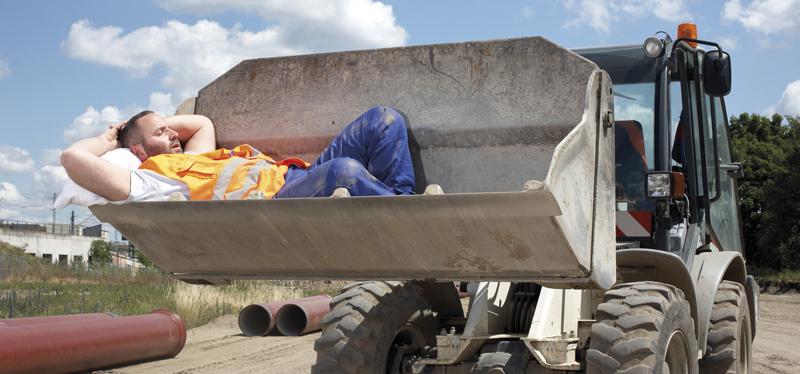1. Adequate sleep is essential for maintaining and restoring full human functioning
Most humans need an average of around 7.5–9 hours of good quality sleep a night for consistent physical and mental recovery from daily activities. Getting adequate sleep is the only way to recover from fatigue, especially for the brain. Just as muscle fatigue can only be reversed through rest, mental fatigue can only be reversed through sleep.
Sleepiness, like hunger and thirst, is a signal from the body of a basic need. In extreme sleepiness, a person may begin to ‘nod off’ without being aware of doing so, or even fall asleep.
Work-related sleep loss is a significant public health issue. In a recent survey, 37 percent of New Zealanders aged 30 to 60 years said that they ‘never’ or ‘rarely’ got enough sleep at night, and 46 percent said they ‘never’ or ‘rarely’ woke up feeling refreshed.
In the short term, people who do not sleep well tend to eat more, and are more likely to pick up infections. Long-term health effects related to sleep problems include digestive system upset, cardiovascular disease, and other complaints.
Implications for employers
When employees’ sleep is affected by shift work (particularly night work) they will not function as effectively as employees who work normal day shifts.
Aim to manage shift work and overtime so that employees have regular opportunities for adequate recovery through high quality sleep.
2. Stimulants provide only limited, short-term relief
The use of stimulants such as nicotine, caffeine, and some other drugs can help maintain alertness in the short term. However, this gain comes at a cost – the ‘crash’ when the effects of the stimulants wear off. Poor quality sleep may result from carry-over effects of the stimulants.
Sleeping tablets can reduce fatigue effectively if used appropriately and for limited periods. However, they just mask the problem if the causes of sleep problems remain unchanged. Only good quality, natural sleep will provide full recovery.
Implications for employers
Providing coffee is not a solution to workplace fatigue. You need to manage shift work in ways that reduce employees’ need for stimulants.
3. Fatigue leads to physical and mental impairment
Laboratory studies indicate that fatigue impairment can be equal to or greater than alcohol impairment.
In the workplace, fatigue may cause workers to:
- Feel sleepy
- Find it hard to pay attention
- Have slower reaction times and poorer coordination
- Have slower, muddled thinking
Implications for employers
Evaluate the risks posed by tasks performed when levels of fatigue
can be expected to be high, and have systems in place to detect fatigue impairment. Design work to prevent fatigue accumulating, and support recovery by providing adequate opportunities for high quality sleep.
4. Shift work (particularly night work) can be a significant cause of fatigue
While shift work in itself inevitably produces fatigue, it is not the only direct cause. Shift work acts as a cause of fatigue along with other work and non-work factors.
Other causes of shift worker fatigue may include:
- Physical and mental task demands – high workload, lack of breaks, work duration, type of work, work scheduling, unpredictability of hours of work.
- Environmental factors such as noise, artificial light, heat, humidity, and vibration .
- Biological factors – lack of sleep, less functional times in the body’s daily cycle, poor health.
- Activities away from work – family responsibilities, social commitments, commuting.
- Shift workers have more accidents commuting to and from work than non-shift workers, which are likely to be caused by fatigue.
Implications for employers
You need to be especially alert to the possibility of fatigue-induced impairment in shift workers by:
- Identifying the times when workers are more likely to be affected by fatigue
- Timing the starting and ending points of shift rosters to minimise fatigue
- Applying and following the types of strategies described in part 2
5. Alertness and capability vary with the time of day
People’s ability to be alert or to focus attention is not constant throughout the course of a day. There are two low points during the 24-hour cycle, which occur for most people somewhere between 3.00 and 5.00am, and again between 3.00 and 5.00pm.
These low points are reflected in the times when most fatigue-related driving accidents happen.
Implications for employers
This information has possible implications for:
- Task scheduling.
- Performance expectations.
- The number, length, and use of breaks.
Shift workers may be less able to assess their safety and modify their behaviour during the low-functionality times of day or night. You and your employees need to agree to take a conservative approach to safety at those times.
The particular measures you take to prevent fatigue-related errors will depend on the risk – how likely such errors are, and how serious their consequences would be.
6. People are programmed to be awake during the day and asleep at night
Humans have an inbuilt ‘body clock’ that controls daily rhythms of alertness and sleepiness.
When people do shift work they must try to override the body clock to remain active at night when the body wants to sleep, and to sleep when the body wants to be active. As a result, they may be working when they are at their least functional and most error-prone, and not getting enough sleep between shifts to recover fully.
The body clock seldom adapts fully to shift work. An exception is when workers are never exposed to daylight at all. Workers on oil platforms in the North Sea, for example, almost completely reverse their body rhythms after 2 weeks of working in this way.
Implications for employers
Try to minimise disruption to natural rhythms when planning shift work. Provide a roster that allows employees to regularly reset their body clocks to the natural rhythms.
7. The ability to fall asleep easily varies with the time of day
Generally speaking, most people fall asleep naturally somewhere between 10.00 and 11.00pm, (although people do vary, with some preferring to go to bed earlier, and others preferring to stay up later). There is a period of wakefulness before this, from around 6.00pm to 10.00pm, when it is difficult for most people to fall asleep.
It is also difficult to fall asleep when the internal drive to be awake reaches its daily peak. This happens about six hours after the early-morning peak in sleepiness; that is, late morning for most people. It may be slightly later after a series of night shifts.
Implications for employers
Where practicable, avoid or minimise consecutive shifts that mean employees will need to sleep at those times when falling asleep is most difficult.
8. How much time people need to recover from fatigue depends on the time of day
This fact, together with the following one (sleep loss is cumulative), means that while it is reasonable to expect employees to get adequate sleep during a normal overnight break of 12 hours, it is not reasonable to expect that they will get adequate sleep in a 12-hour break that begins in the morning.
Implications for employers
If possible, allow employees longer periods off if they must sleep during the day.
9. Sleep loss is cumulative
As a pattern of shift work continues, the effects of sleep loss and poor-quality sleep accumulate, leading to increasing sleepiness and performance impairment.
Two full nights of unbroken sleep within the normal self-selected sleep time of 10.00pm to 8.00am, with a normal day in between, are a minimum requirement for adequate recovery after periods of overnight work.
Implications for employers
Provide breaks with at least two full nights off (and where normal day-oriented functioning is possible) as part of the normal shift roster.
Depending on when the time-off period begins, this may mean providing a period longer than 48 hours. For example, a 48-hour break beginning at midnight gives only one full night of uninterrupted sleep. Shift workers who cross time zones (such as international pilots) will have additional problems that need special measures.
10. Various strategies can minimise fatigue and promote better sleep
Good education about fatigue leads to common understanding and appropriate workplace-specific solutions. Shift workers can be given strategies to improve their quality of life and sleep, such as improving their sleep facilities, and avoiding caffeine or alcohol within the hours before sleep.
Make sure you cover the following topics in your information and training sessions:
- Adjusting the sleeping area to promote good sleep.
- Good nutrition while working shifts.
- Use and avoidance of stimulants.
- Recognising fatigue.
- Getting to and from work safely.
- Fitness and exercise.
- Effective napping.
- Maintaining home and family life.
- Childcare arrangements.
- Equal facilities for shift workers.
- Implications for employers
Provide training in fatigue management strategies before an employee begins shift work. Education and training are an important part of any shift work management system, but they are never a complete solution.
11. Preventing workplace fatigue requires cooperation and compromise
Shift-working arrangements are a compromise between the business’s need for work to continue at a time when people are normally asleep, and employees’ need to recover adequately through quality sleep.
Finding compromises that are acceptable to the greatest number of people will require employee involvement and participation. Some rosters are better than others, but everyone involved needs to accept that there is no ‘perfect’ night-shift roster.
Bear in mind that:
- There is a sense that the most successful roster is the one that staff prefer.
- People adapt their lives to any arrangements over time, and changing arrangements can be seen as a threat to their adaptations.
- If a roster never changes, it cannot be improved.
Implications for employers
The success of any shift-working arrangements will largely depend on the quality of the consultation process. People taking on shift work need reliable, basic information to make informed choices. Changing shift-working arrangements is a major undertaking. Employees will need time to adjust.
12. Various strategies are available for managing shift work to minimise fatigue
Strategies available for assessing and managing shift work include standard audit frameworks, roster design principles, risk assessment tools, and fatigue modelling methods.
There are various tools to use in developing these systems:
- Faid fatigue safety system – see www.faidsafe.com
- Australia New Zealand Standard 4360:1999 – risk management.
Implications for employers
No single method of shift work management will fit all circumstances. Whichever method you use, you will need to tailor it to the needs of the organisation.
WORKSAFE.GOVT.NZ






